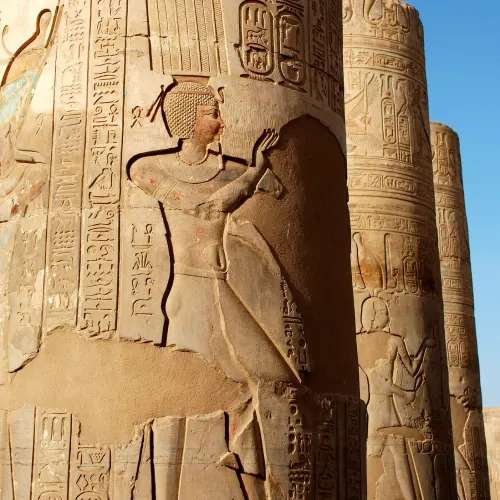Historical Cairo
Coptic Cairo
Old Cairo covers a large area south of Garden City, known to some as Coptic Cairo. Coptic Cairo encompasses many important Coptic monuments and historical sites including the Babylon Fortress, the Coptic Museum, the Hanging Church, and the Greek Church of St. George. Many believe that the Holy Family passed through this area and stayed at the site of Saints Sergius and Bacchus Church (Abu Serga). Coptic Cairo was once a very important place for Christian in Egypt, even after the Muslim conquest.
In 1047, the Hanging Church become the official home of the Coptic Pope. It is one of the oldest Coptic monuments, dating back to the 3rd century. It gets its name as it was constructed on top of the Babylon Fortress’s gatehouse.
In 1908, the Coptic Museum was constructed in Coptic Cairo by Marcus Simaika Pasha, a prominent Egyptian Coptic politician, and leader. It opened its door two years later. Now, this museum is home to the world’s largest collection of Coptic artistry.
Coptic Cairo also features a number of other historically significant churches including Saint Mary Church, Saint Mercurius Church, Saints Sergius and Bacchus Church, Church of the Holy Virgin, Saint Barbara Church, The Church of Saint Menas, Nunnery and Church of St. George, and Monastery and Church of St. George.
The Coptic Museum
The Coptic Museum is home to the world’s largest collection of Coptic artifacts in the world and was inaugurated in 1910. The museum was established as a way to preserve Coptic heritage. Simaika Pasha bought and collected Coptic antiquities from older churches undergoing renovation, and used them to build the museum and establish its impressive collection.
The collection reflects the long and rich history of the Coptic Christians from its inception in Egypt to its rise as the stronghold of Christianity. Coptics trace their origins to Saint Mark who visited Alexandria in the first century. The items on display show the interweaving of Coptic art with the various cultures and civilizations that have passed through Egypt: Pharaonic, Greek, Roman, Byzantine, and Ottoman.
Marvel at ornate manuscripts, hand-carved woodwork, detailed frescos depicting important religious scenes from ancient monasteries and churches.
The Hanging Church
The Hanging Church, once dubbed the ‘Staircase Church’ by early travelers to Cairo, the magnificent church is framed by 29 steps. The church was most likely built during the patriarchate of Isaac (690–692).
The earliest mention of the Hanging Church was in the biography of the patriarch Joseph I (831–849), when the governor of Egypt visited. The church was reconstructed by Pope Abraham and has undergone numerous restorations including a massive repair and restoration recently in 2011. Objects of historical importance that were no longer used were sent to the Coptic Museum.
The Hanging Church is one of the earliest churches built in Cairo, although it was restored in the sixth century, losing a wealth of its older architecture. In 1992, an earthquake shook the establishment to its core.
Al-Fustat
With the Arab conquest, Caliph Omar ibn al-Khattab desired a new capital for Egypt, declining Alexandria. Intead Fustat, or al-Fustat, was founded by ‘Amr ibn al-‘As a year later, making it Egypt’s first Islamic capital.
The city tooks its name from the word fustat, which actually means “tent”. This honors the camp set up of ‘Amr ibn al-‘A’s army built on the site where the companions of the Prophet gathered. The first-ever building constructed was the mosque of Amr ibn al-‘As, known as the Old (Mosque), which was built on the site of the tent in which most of the companions of the Prophet Muhammad gathered.
In modernity, al-Fustat is part of the broader Old Cairo District. It is brimming with many historically important archaeological sites, including the Synagogue of Ben E'zra, several ancient churches, the Mosque of ‘Amr ibn al-‘As, the remains of the old city of al-Fustat, the Nilometer, the palace of al-Manesterley, and Mohammad Ali Palace.
The Citadel
The Citadel of Sultan Salah al-Din al-Ayyubi is one of Islamic Cairo’s most popular monuments. It is also one of the most awe-inspiring defensive fortresses from the Middle Ages. Its strategic location atop Muqattam Hills made for a formidable defensive position and offers an unrivaled view of Cairo.
Sultan Salah al-Din al-Ayyubi was the first to begin the construction of the fortress but it was not finished in his life. The structure was completed during the reign of Sultan Kamel ibn al-Adel who actually lived in it, officiating as the primary residence of Egypt’s rulers. In the middle of the nineteenth century, Khedive Ismail shifted the official residence to Abdeen Palace in downtown Cairo instead.
The Citadel played a key role in a number of significant events in Egypt’s history from its construction to the end of the Muhammad Ali Dynasty to the birth of the modern Egyptian republic. A lot of monuments have been to the Citadel over the centuries, offering visitors an array of sites to visit, such as the Mosque of Muhammad Ali Pasha inside.
The Mosque of ‘Amr ibn Al ‘As
The mosque of ‘Amr ibn al-‘As is Egypt and Africa’s oldest surviving mosque. General ʿAmr ibn al-ʿAs was one of the Prophet’s earliest companions. After conquering Egypt in 640 AD, the general founded its first Islamic capital, which falls today within the boundaries of modern Cairo. A year later, the mosque was founded becoming the new capital’s first building.
During the years after the conquest, the mosque was the main spot for the gathering of the Muslim community and the general’s troops. A handful of the companions helped in the building’s construction, including al-Zubayr ibn al-‘Awam and Ubada ibn al-Samit.
The structure underwent a lot of damage over time, and has witnesses numerous architectural changes throughout its long history. Not much of the original remains today. What you will find today is a 20th century reconstruction. It stays true to the simplicity of early Islamic architecture.
Al-Mu'izz Street
Al-Mu’izz Street is named after the Fatimid Caliph, al-Mu’izz li-Din Allah, the founder of the street. It is the world’s largest open-air museum for Islamic monuments, a UNESCO World Heritage site since 1979.
The winding street stretches from Bab al-Futuh in the north to Bab Zuwayla in the south, slipping past a number of medieval era alleys and streets including Amir al-Juyush Street, Darb al-Asfar and Bergowan Alley, Khan al-Khalili and al-Ghuriyya.
29 monuments in total are located at al-Mu’izz that allow visitors to experience Islamic Egypt from the Fatimid Period to the Muhammad Ali Dynasty. These monuments include an arrway of strcutures whether religious, commercial or defensive in nature. Today, you will find a colorful variety of markets, vendors, and crafts stores dotting the street, adding an added level of charm.
RELATED TOURS
RECENT REVIEWS
What people say about us
© 2023 Copyright to Go Elite Club
terms and conditions




